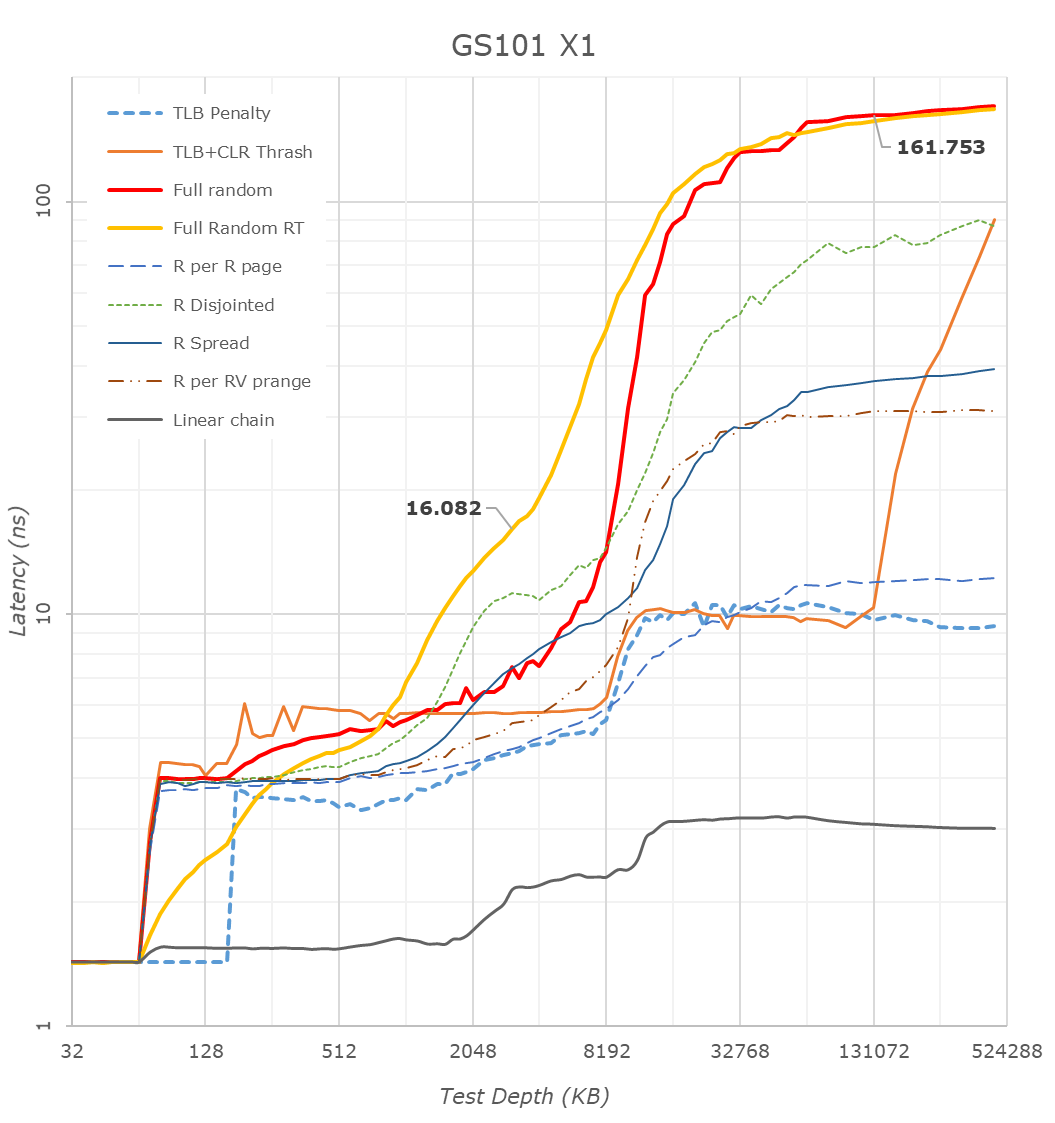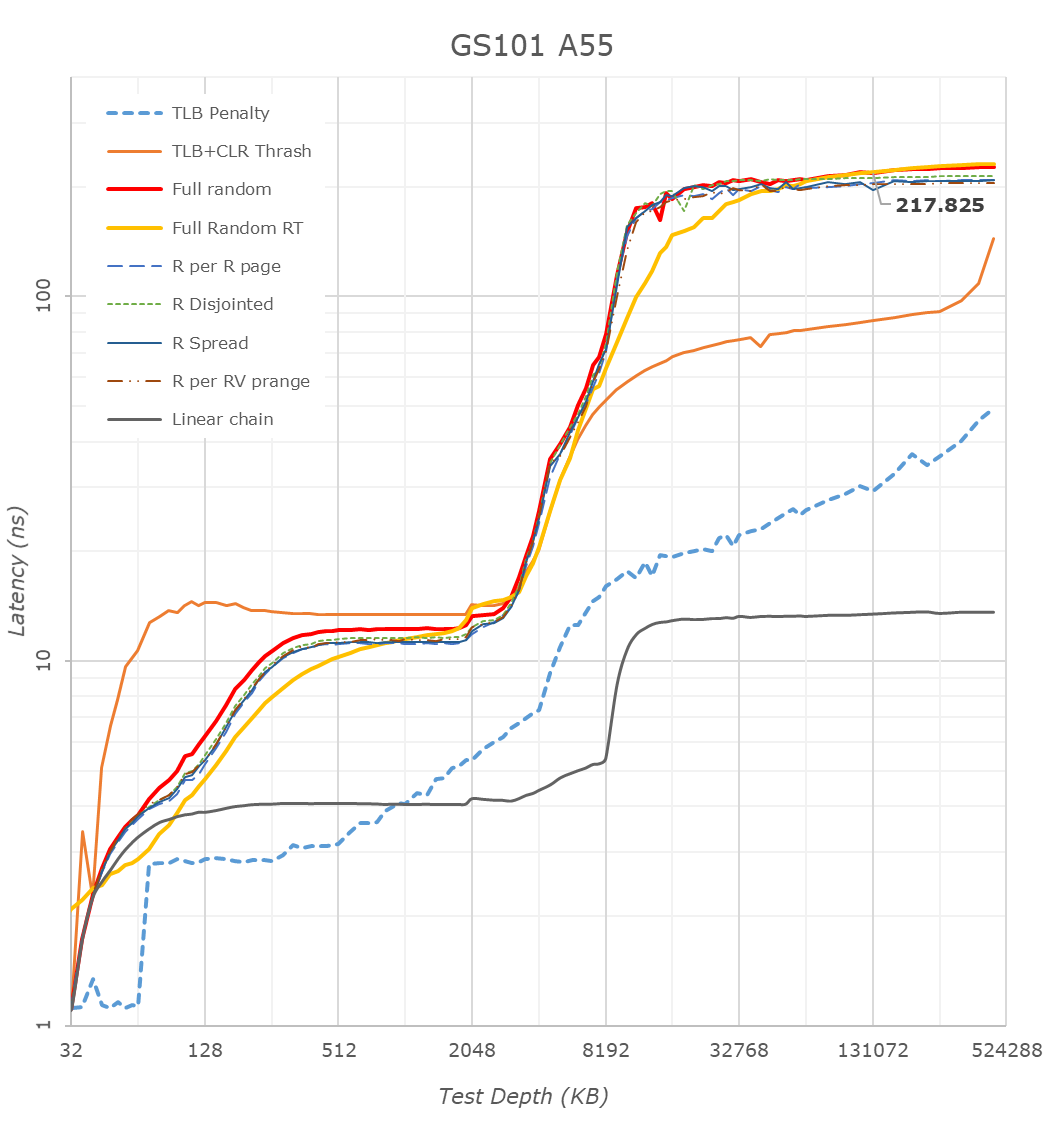Google's Tensor inside of Pixel 6, Pixel 6 Pro: A Look into Performance & Efficiency
by Andrei Frumusanu on November 2, 2021 8:00 AM EST- Posted in
- Mobile
- Smartphones
- SoCs
- Pixel 6
- Pixel 6 Pro
- Google Tensor
Memory Subsystem & Latency
Usually, the first concern of a SoC design, is that it requires that it performs well in terms of its data fabric and properly giving its IP blocks access to the caches and DRAM of the system within good latency metrics, as latency, especially on the CPU side, is directly proportional to the end-result performance under many workloads.
The Google Tensor, is both similar, but different to the Exynos chips in this regard. Google does however fundamentally change how the internal fabric of the chip is set up in terms of various buses and interconnects, so we do expect some differences.
First off, we have to mention that many of the latency patterns here are still quite a broken due to the new Arm temporal prefetchers that were introduced with the Cortex-X1 and A78 series CPUs – please just pay attention to the orange “Full Random RT” curve which bypasses these.
There’s a couple of things to see here, let’s start at the CPU side, where we see the X1 cores of the Tensor chip being configured with 1MB of L2, which comes in contrast with the smaller 512KB of the Exynos 2100, but in line with what we see on the Snapdragon 888.
The second thing to note, is that it looks like the Tensor’s DRAM latency isn’t good, and showcases a considerable regression compared to the Exynos 2100, which in turn was quite worse off than the Snapdragon 888. While the measurements are correct in what they’re measuring, the problem is a bit more complex in the way that Google is operating the memory controllers on the Google Tensor. For the CPUs, Google is tying the MCs and DRAM speed based on performance counters of the CPUs and the actual workload IPC as well as memory stall % of the cores, which is different to the way Samsung runs things which are more transactional utilisation rate of the memory controllers. I’m not sure of the high memory latency figures of the CPUs are caused by this, or rather by simply having a higher latency fabric within the SoC as I wasn’t able to confirm the runtime operational frequencies of the memory during the tests on this unrooted device. However, it’s a topic which we’ll see brought up a few more times in the next few pages, especially on the CPU performance evaluation of things.
The Cortex-A76 view of things looks more normal in terms of latencies as things don’t get impacted by the temporal prefetchers, still, the latencies here are significantly higher than on competitor SoCs, on all patterns.
What I found weird, was that the L3 latencies of the Tensor SoC also look to be quite high, above that of the Exynos 2100 and Snapdragon 888 by quite a noticeable margin. I noted that one weird thing about the Tensor SoC, is that Google didn’t give the DSU and the L3 cache of the CPU cluster a dedicated clock plane, rather tying it to the frequency of the Cortex-A55 cores. The odd thing here is that, even if the X1 or A76 cores are under full load, the A55 cores as well as the L3 are still running at lower frequencies. The same scenario on the Exynos or Snapdragon chip would raise the frequency of the L3. This behaviour and aspect of the chip can be confirmed by running at dummy load on the Cortex-A55 cores in order to drive the L3 higher, which improves the figures on both the X1 and A76 cores.
The system level cache is visible in the latency hump starting at around 11-13MB (1MB L2 + 4MB L3 + 8MB SLC). I’m not showing it in the graphs here, but memory bandwidth on normal accesses on the Google chip is also slower than on the Exynos, but I think I do see more fabric bandwidth when doing things such as modifying individual cache lines – one of the reasons I think the SLC architecture is different than what’s on the Exynos 2100.
The A55 cores on the Google Tensor have 128KB of L2 cache. What’s interesting here is that because the L3 is on the same clock plane as the Cortex-A55 cores, and it runs at the same higher frequencies, is that the Tensor’s A55s have the lowest L3 latencies of the all the SoCs, as they do without an asynchronous clock bridge between the blocks. Like on the Exynos, there’s some sort of increase at 2MB, something we don’t see on the Snapdragon 888, and I think is related to how the L3 is implemented on the chips.
Overall, the Tensor SoC is quite different here in how it’s operated, and there’s some key behaviours that we’ll have to keep in mind for the performance evaluation part.












108 Comments
View All Comments
TheinsanegamerN - Tuesday, November 2, 2021 - link
Not cheap, just poorly designed. Too much focus on magic and not enough on the fundamentals of a good chip design.Alistair - Wednesday, November 3, 2021 - link
cheaply made, i mean, with a CPU with A76 cores... lol...tuxRoller - Tuesday, November 2, 2021 - link
All companies other than those that Apple need should just admit defeat and give themselves over.Just needed to be said.
TheinsanegamerN - Tuesday, November 2, 2021 - link
The rest of the world is not america. Without america apple is a tiny minority of devices.Alistair - Wednesday, November 3, 2021 - link
? seriously? Apple is dominant in Japan, Taiwan, and a gazillion other countriesicedeocampo - Wednesday, November 3, 2021 - link
last time I checked there were just 195 countriesAlistair - Wednesday, November 3, 2021 - link
you know hyperbole right? your response is not an argument...ss91 - Thursday, November 4, 2021 - link
You both are wrong. Yes, it’s true apple is not the majority device supplier. Yes, it’s also true that apple is far far ahead.But what is wrong is that
1. @TheinsanegamerN : Where apple doesn’t dominate, they are predominantly lower segment markets where avg smartphone price is far below the cheapest iPhone.
Apple sells more iPhones than Samsung sells Notes (RIP), S series and fold/flip. Samsung sells overall more phones because they operate in price segments all the way from $200 to $2000 while apple starts $400.
You can be sure that SE Asia, S.America and Africa uses androids, but it’s also true that these androids are far from the bleeding edge flagships.
2. @tuxRoller : Competition is important. If Samsung won’t team up with AMD, Adreno and Mail will become complicit. If Tensor doesn’t outperform ML tasks, exynos and Qualcomm won’t innovate there. If apple won’t have started the 64bit and Custom CPU race, nothing would be same today.
tuxRoller - Friday, November 5, 2021 - link
Sorry for the bit of trolling, but, to be clear, that was trolling. I wasn't being serious.aclos3 - Wednesday, November 3, 2021 - link
I am really happy with my Pixel 6 pro so far. Above all, I want my phone to have a really excellent camera and every new mid to high end phone now is plenty fast for just about any use. I bet the Pixel 6 takes much better pictures than whatever "trash" you are using. But you sure have them beat when it comes to the benchmarks I bet.